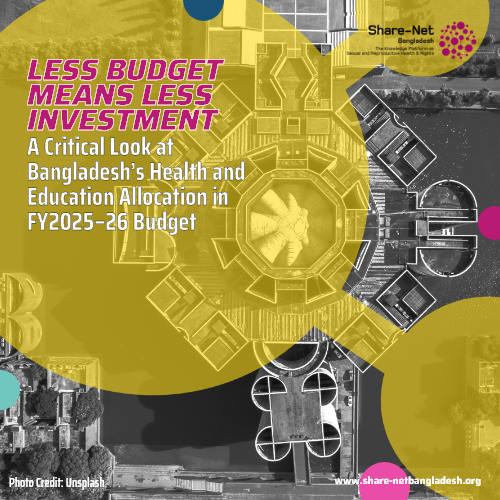Less Budget Means Less Investment: A Critical Look at Bangladesh’s FY2025–26 Health and Education Allocation
The proposed national budget for FY2025–26 has promised a shift in focus—from physical infrastructure to people-centered sectors like health, education, and governance. But a closer look reveals that this promise barely holds up when examined against actual figures.
The Crisis Behind the Numbers
Despite rhetorical commitments, both education and health have seen only marginal increases in allocations. The education sector received BDT 95,644 crore, just 0.23% higher than the previous year, while its share in GDP stands at only 1.72%. This falls drastically short of UNESCO’s recommended 4–6% of GDP.
Similarly, the health sector received BDT 41,908 crore, up by just BDT 500 crore—a meagre 0.1% increase from last year, accounting for only 5.3% of the national budget. This is far below the 15% target proposed by the Health Reform Commission.
Such underinvestment has direct and dangerous consequences for Sexual and Reproductive Health and Rights (SRHR). Poor access to maternal healthcare, low contraceptive availability, and limited adolescent SRHR services disproportionately affect low-income women and marginalised groups.
Why the Crisis Persists
Policy experts point to two primary failures: a lack of strategic planning and weak budget implementation capacity.
“Even if the budget numbers are small, what’s worse is that the ministries can’t even spend what they’re given,” said Prof. Syed Abdul Hamid, a health economist at Dhaka University. In April, the Health, Education and Family Welfare Division had utilised only 2.34% of its revised ADP allocation—the lowest among all ministries.
Meanwhile, educationists have raised alarms over chronic stagnation in policy reform. “We have seen no effort for structural change in education,” said Prof. Manzoor Ahmed, Emeritus Professor at BRAC University. “It’s just recycled rhetoric, without any roadmap or results.”
Rasheda K. Chowdhury, former adviser to the caretaker government, echoed similar concerns: “The government shows good intent, but there’s no forward path. How can we move if there’s no map?”
A Gendered Fallout
The lack of investment in health and education especially impacts women and girls. Low funding in maternal health services, poor SRHR education in schools, and a fragile health system all translate into higher maternal mortality, unsafe abortions, and school dropouts due to early pregnancy.
What Must Be Done
Without bold reforms and real political will, Bangladesh will struggle to achieve Universal Health Coverage by 2030, a goal it reaffirmed in the budget speech. Experts recommend:
-
Increasing SRHR-specific budget lines
-
Ensuring 100% budget utilization with transparent monitoring
-
Implementing school-based SRHR education
-
Guaranteeing free maternal care in rural and urban clinics
The government’s intent may be in the right place, but intent without investment is just aspiration.
“There’s no work, there’s no budget—how can we expect results?” asked Prof. Manzoor.
Now that’s a question policymakers should answer with honesty.
Source: Daily Star


